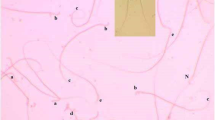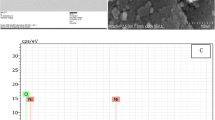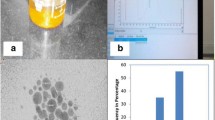Abstract
Fifty male mice were exposed to 50 nm unmodified nano-ZnO through intragastric administration for 90 days to detect the long-term effects of unmodified nano-ZnO in mice. Results showed that the blood glucose, serum follicle stimulating hormone, luteinizing hormone, testosterone, and estradiol were significantly decreased (p < 0.05). The serum triglyceride, total cholesterol, and low-density lipoprotein were significantly increased (p < 0.05). The semen quality of the 160 mg/kg·bw group were significantly lowered (p < 0.05). The liver and testis catalase and CuZn-SOD activities were significantly elevated (p < 0.05). The abilities of •OH inhibition in the livers and testes of the 160 mg/kg·bw group were significantly lowered (p < 0.05). The liver and testis MDA levels of the 160 mg/kg·bw group were significantly elevated (p < 0.05). Results indicate that exposure of nano-ZnO could induce lipid metabolism disorder, hyperlipidemia, and reproductive toxicity to male mice through oxidative injury.

Similar content being viewed by others
Change history
24 July 2019
The original version of this article unfortunately contained a mistake. The correct title should be “The Effects of 50 nm Unmodified Nano-ZnO on Lipid Metabolism and Semen Quality in Male Mice”. The original article has been corrected.
References
Boekelheide K, Fleming SL, Johnson KJ, Patel SR, Schoenfeld HA (2000) Role of Sertoli cells in injury-associated testicular germ cell apoptosis. Exp Biol Med 225:105–115
Braydich-Stolle LK, Lucas B, Schrand A, Murdock RC, Lee T, Schlager JJ, Hussain SM, Hofmann MC (2010) Silver nanoparticles disrupt GDNF/Fyn kinase signaling in spermatogonial stem cells. Toxicol Sci 116:577–589
Chen N, Wang H, Huang Q, Li J, Yan J, He DN et al (2014) Long-term effects of nanoparticles on nutrition and metabolism. Small 10(18):3603–3611
Cho WS, Kang BC, Lee JK, Jeong J, Che JH, Hyeok SS et al (2013) Comparative absorption, distribution, and excretion of titanium dioxide and zinc oxide nanoparticles after repeated oral administration. Particle and Fibre Toxicology. 10:9
Esmaeillou M, Moharamnejad M, Hsankhani R, Tehrani AA, Maadi H (2013) Toxicity of ZnO nanoparticles in healthy adult mice. Environ Toxicol Pharmacol 35:67–71
Ghosh M, Sinha S, Jothiramajayam M, Jana A, Nag A, Mukherjee A (2016) Cytogenoto- xicity and oxidative stress induced by zinc oxide nanoparticle in human lymphocyte cells in vitro and Swiss albino male mice in vivo. Food Chem Toxicol 97:286–296
Guo DD, Bi HS, Liu B, Wu QX, Wang DG, Cui Y (2013) Reactive oxygen species-induced cytotoxic effects of zinc oxide nanoparticles in rat retinal ganglion cells. Toxicol in Vitro 27:731–738
Heim J, Felder E, Tahir MN, Kaltbeitzel A, Heinrich UR, Brochhausen C, Mailänder V, Tremel W, Brieger J (2015) Genotoxic effects of zinc oxide nanoparticles. Nanoscale 7(19):8931–8938
Heng BC, Zhao XX, Xiong SJ, Ng KW, Boey FYC, Loo JSC (2010) Toxicity of zinc oxide (ZnO) nanoparticles on human bronchial epithelial cells (BEAS-2B) is accentuated by oxidative stress. Food and Chemical Toxicology. 48(6), 1762–1766
Hussain N, Jaitley V, Florence AT (2001) Recent advances in the understanding of uptake of microparticulates across the gastrointestinal lymphatics. Adv Drug Deliv Rev 50:107–142
Jacobsen NR, Stoeger T, Van Den Brule S, Saber AT, Beyerle A, Vietti G et al (2015) Acute and subacute pulmonary toxicity and mortality in mice after intratracheal instillation of ZnO nanoparticles in three laboratories. Food Chem Toxicol 85:84–95
Jia JB, Li FF, Zhou HY, Bai YH, Liu SJ, Jiang YG et al (2017) Oral exposure to silver nanoparticles or silver ions may aggravate fatty liver disease in overweight mice. Environ Sci Technol 51:9334–9343
Khorsandi L, Orazizadeh M, Moradi-Gharibvand N, Hemadi M, Mansouri E (2017) Beneficial effects of quercetin on titanium dioxide nanoparticles induced spermatogenesis defects in mice. Environ Sci Pollut Res 24:5595–5606
Kim CS, Nguyen HD, Ignacio RM, Kim JH, Cho YC, Maeng EH et al (2014a) Immunotoxicity of zinc oxide nanoparticles with different size and electrostatic charge. Int J Nanomedicine 9(Suppl 2):195–205
Kim YR, Park J, Lee EJ, Park SH, Seong NW, Kim JH (2014b) Toxicity of 100 nm zinc oxide nanoparticles: a report of 90-day repeated oral administration in Sprague Dawley rats. Int J Nanomedicine 9(Suppl 2):109–126
Kong T, Zhang SH, Zhang JL, Hao XQ, Yang F, Zhang C, Yang ZJ, Zhang MY, Wang J (2018) Acute and cumulative effects of unmodified 50-nm nano-ZnO on mice. Biol Trace Elem Res 185(1):124–134
Kong T, Zhang SH, Zhang C, Zhang JL, Yang F, Wang GY, Yang ZJ, Bai DY, Zhang MY, Wang J, Zhang BH (2019) Long-term effects of unmodified 50 nm ZnO in mice. Biol Trace Elem Res 189(2):478–489
Kwon JT, Hwang SK, Jin H, Kim DS, Minai-Tehrani A, Yoon HJ (2008) Body distribution of inhaled fluorescent magnetic nanoparticles in the mice. J Occup Health 50:1–6
Lee CM, Jeong HJ, Yun KN, Kim DW, Sohn MH, Lee JK et al (2012) Optical imaging to trace near infrared fluorescent zinc oxide nanoparticles following oral exposure. International Journal of Nanomedicine. 7:3203–3209
Li MZ, Huang JT, Tsai YH, Mao SY, Fu CM, Lien TF (2016) Nanosize of zinc oxide and the effects on zinc digestibility, growth performances, immune response and serum parameters of weanling piglets. Anim Sci J 87(11):1379–1385
Li JY, Zheng XY, Ma XY, Xu XY, Du Y, Lv QJ et al (2019) Melatonin protects against chromium(VI)-induced cardiac injury via activating the AMPK/Nrf2 pathway. J Inorg Biochem 197:110698
Liu BY, Bing QZ, Li SY, Han B, Lu JJ, Baiyun RQ et al (2019) Role of A2B adenosine receptor-dependent adenosine signaling in multi-walled carbon nanotube-triggered lung fibrosis in mice. J Nanobiotechnol 17:45
Mantecca P, Moschini E, Bonfanti P, Fascio U, Perelshtein I, Lipovsky A, Chirico G, Bacchetta R, del Giacco L, Colombo A, Gedanken A (2015) Toxicity evaluation of a new Zn-doped CuO nanocomposite with highly effective antibacterial properties. Toxicol Sci 146(1):16–30
Mao SY, Lien TF (2017) Effects of nanosized zinc oxide and γ-polyglutamic acid on eggshell quality and serum parameters of aged laying hens. Arch Anim Nutr 71(5):373–383
Moghaddasia S, Fotovata A, Khoshgoftarmaneshb AH, Karimzadehc F, Khazaeid HR, Khorassania R (2017) Bioavailability of coated and uncoated ZnO nanoparticles to cucumber in soil with or without organic matter. Ecotoxicology and Environmental Safety. 144:543–551
Oberdorster G, Oberdorster E, Oberdorster J (2005) Nanotoxicology: an emerging discipline evolving from studies of ultrafine particles. Environ Health Perspect 113:823–839
Oliviero M, Schiavo S, Rametta G, LuciaMiglietta M, Manzo S (2017) Different sizes of ZnO diversely affected the cytogenesis of the sea urchin Paracentrotus lividus. Sci Total Environ 607-608:176–183
Park HS, Shin SS, Meang EH, Hong JS, Park J, Kim SH et al (2014) A 90-day study of subchronic oral toxicity of 20 nm, negatively charged zinc oxide nanoparticles in Sprague Dawley rats. Int J Nanomedicine 9(Suppl 2):79–92
Patil NA, Gade WN, Deobagkar DD (2016) Epigenetic modulation upon exposure of lung fibroblasts to TiO2 and ZnO nanoparticles: alterations in DNAmethylation. Int J Nanomedicine 11:4509–4519
Petrick L, Rosenblat M, Paland N, Aviram M (2016) Silicon dioxide nanoparticles increase macrophage atherogenicity: stimulation of cellular cytotoxicity, oxidative stress, and triglycerides accumulation. Environ Toxicol 31(6):713–723
Ruwanpura SM, McLachlan RI, Meachem SJ (2010) Hormonal regulation of male germ cell development. J Endocrinol 205:117–131
Shalini D, Senthilkumar S, Rajaguru P (2017) Effect of size and shape on toxicity of Zinc Oxide (ZnO) nanomaterials in human peripheral blood lymphocytes. Toxicol Mech Methods 13:1–28
Sharma V, Anderson D, Dhawan A (2011) Zinc oxide nanoparticles induce oxidative stress and genotoxicity in human liver cells (HepG2). J Biomed Nanotechnol 7(1):98–99
Sharma V, Singh P, Pandey AK, Dhawan A (2012) Induction of oxidative stress, DNA damage and apoptosis in mouse liver after sub-acute oral exposure to zinc oxide nanoparticles. Mutat Res Genet Toxicol Environ Mutagen 745:84–91
Takeda K, Suzuki K, Ishihara A (2009) Nanoparticles transferred from pregnant mice to their offspring can damage the genital and cranial nerve systems. J Health Sci 55:95–102
Talebi AR, Khorsandi L, Moridian M (2013) The effect of zinc oxide nanoparticles on mouse spermatogenesis. J Assist Reprod Genet 30:1203–1209
Tan X, Liu BY, Lu JJ, Li SY, Baiyun RQ, Lv YY et al (2018) Dietary luteolin protects against HgCl2-induced renal injury via activation of Nrf2-mediated signaling in rat. J Inorg Biochem 179:24–31
Turgut G, Abban G, Turgut S, TAKE G (2003) Effect of overdose Zinc on mouse testis and its relation with sperm count and motility. Biol Trace Elem Res 96(1-3):271–279
Wang B, Feng WY, Wang M, Wang TC, Gu YQ, Zhu MT (2008) Acute toxicological impact of nano- and submicro-scaled zinc oxide powder on healthy adult mice. J Nanopart Res 10:263–276
Wang C, Cheng K, Zhou L, He JT, Zheng XC, Zhang LL et al (2017) Evaluation of long-term toxicity of oral zinc oxide nanoparticles and zinc sulfate in mice. Biol Trace Elem Res 178:276–282
Wang B, Zhang J, Chen CZ, Xu G, Qin X, Hong YL et al (2018) The size of zinc oxide nanoparticles controls its toxicity through impairing autophagic flux in A549 lung epithelial cells. Toxicol Lett 285:51–59
Wei LM, Wang JF, Chen AJ, Liu J, Feng XL, Shao LQ (2017) Involvement of PINK1/parkin-mediated mitophagy in ZnO nanoparticle-induced toxicity in BV-2 cells. Int J Nanomedicine 12:1891–1903
Yang QB, Lin TS, Burton C, Park SH, Ma YF (2016) Physicochemical insights of irradiation-enhanced hydroxyl radical generation from ZnO nanoparticles. Toxicol Res 5(2):482–491
Yu KN, Yoon TJ, Minai-Tehrani A, Kim JE, Park SJ, Jeong MS et al (2013) Zinc oxide nanoparticle induced autophagic cell death and mitochondrial damage via reactive oxygen species generation. Toxicol in Vitro 27:1187–1195
Zhang J, Qin X, Wang B, Xu G, Qin ZX, Wang J et al (2017) Zinc oxide nanoparticles harness autophagy to induce cell death in lung epithelial cells. Cell Death Dis 8:e2954
Zhao XS, Ren X, Zhu R, Luo ZY, Ren BX (2016) Zinc oxide nanoparticles induce oxidative DNA damage and ROS-triggered mitochondria-mediated apoptosis in zebrafish embryos. Aquat Toxicol 180:56–70
Funding
This work was supported by the National Natural Science Foundation of China (Nos. 31402263, 31872537, 41301562), the National Natural Science Foundation of Henan province (No. 182300410087), and the Key Scientific and Technological Project of Henan province (No. 182102110257).
Author information
Authors and Affiliations
Corresponding author
Ethics declarations
Conflict of Interest
The authors declare that they have no conflict of interest.
Additional information
Publisher’s Note
Springer Nature remains neutral with regard to jurisdictional claims in published maps and institutional affiliations.
The original version of this article was revised: The correct title should be “The Effects of 50 nm Unmodified Nano-ZnO on Lipid Metabolism and Semen Quality in Male Mice”.
Highlights
• Nano-ZnO could induce lipid metabolism disorder and reproductive toxicity.
• Nano-ZnO showed adverse effects on semen quality and spermatogenesis.
• The lipid metabolism disorder and reproductive toxicity induced by nano-ZnO might be through oxidative stress.
Rights and permissions
About this article
Cite this article
Kong, T., Zhang, SH., Zhang, C. et al. The Effects of 50 nm Unmodified Nano-ZnO on Lipid Metabolism and Semen Quality in Male Mice. Biol Trace Elem Res 194, 432–442 (2020). https://doi.org/10.1007/s12011-019-01792-6
Received:
Accepted:
Published:
Issue Date:
DOI: https://doi.org/10.1007/s12011-019-01792-6




